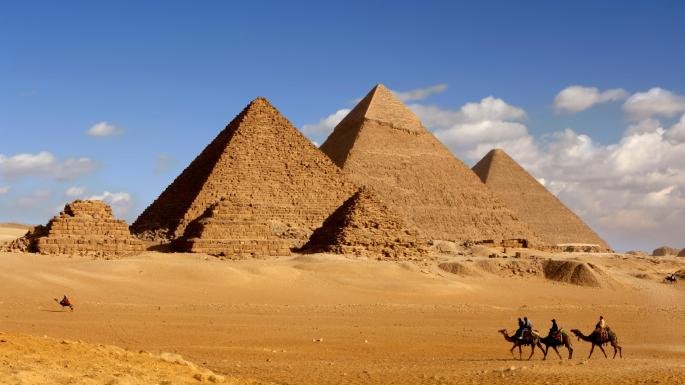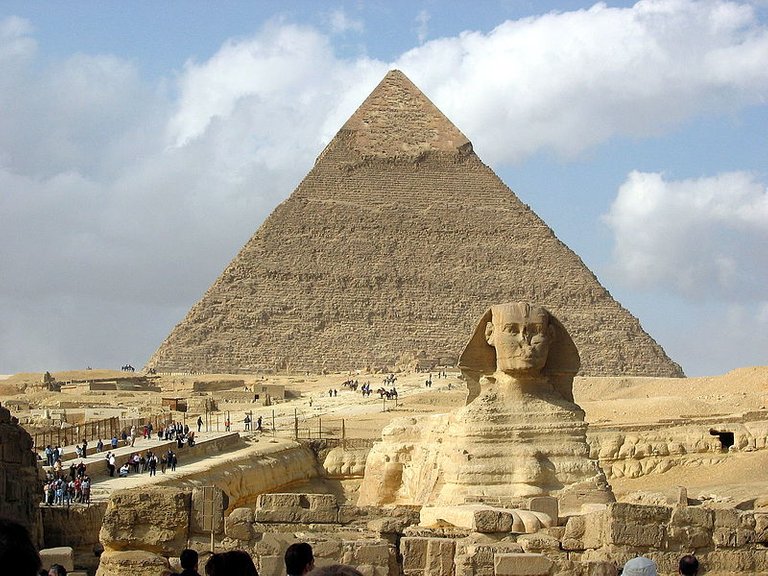Introduction
_06.jpg)
Worked amid a period when Egypt was one of the richest and most intense human advancements on the planet, the pyramids—particularly the Great Pyramids of Giza—are probably the most eminent man-made structures ever. Their gigantic scale mirrors the one of a kind part that the pharaoh, or ruler, played in old Egyptian culture. Despite the fact that pyramids were worked from the earliest starting point of the Old Kingdom to the end of the Ptolemaic time frame in the fourth century A.D., the pinnacle of pyramid building started with the late third line and proceeded until generally the 6th. Over 4,000 years after the fact, the Egyptian pyramids still hold quite a bit of their greatness, giving a look into the nation's rich and magnificent past.
THE GREAT PYRAMID OF GIZA

No pyramids are more celebrated than the Great Pyramids of Giza, orchestrated on a level on the west bank of the Nile River, on the edges of cutting-edge Cairo. The most settled and most noteworthy of the three pyramids at Giza, known as the Great Pyramid, is the essential surviving structure out of them to an extraordinary degree understood seven marvels of the obsolete world. It was worked for Khufu (Cheops, in Greek), Sneferu's successor and the second of the eight pioneers of the fourth line. Despite the manner in which that Khufu ruled for a long time (2589-2566 B.C.), sensibly little is considered his oversee past the gloriousness of his pyramid. The sides of the pyramid's base customary 755.75 feet (230 meters), and its exceptional stature was 481.4 feet (147 meters), making it the best pyramid on the planet. Three little pyramids worked for Khufu's rulers are coordinated by the Great Pyramid, and a tomb was discovered close-by containing the unfilled sarcophagus of his mom, Queen Hetepheres. Like unmistakable pyramids, Khufu's is wrapped by lines of mastabas, where relatives or specialists of the ruler were anchored to keep running with and bolster him in life following passing.
The center pyramid at Giza was worked for Khufu's youth Khafre (2558-2532 B.C). A remarkable segment worked inside Khafre's pyramid complex was the Great Sphinx, a gatekeeper statue cut in limestone with the pioneer of a man and the body of a lion. It was the best statue in the old world, evaluating 240 feet long and 66 feet high. In the eighteenth tradition (c. 1500 B.C.) the Great Sphinx would come to be worshiped itself, as the photograph of a region sort of the god Horus. The southernmost pyramid at Giza was worked for Khafre's tyke Menkaure (2532-2503 B.C.). It is the most succinct of the three pyramids (218 feet) and is an antecedent of the humbler pyramids that would be worked amidst the fifth and 6th lines.
Around 2.3 million squares of stone (averaging around 2.5 tons each) must be cut, transported and amassed to make Khufu's Great Pyramid. The old Greek history genius Herodotus made that it took 20 years to make and required created by 100,000 men, yet later archeological confirmation recommends that the workforce may genuinely have been around 20,000. Regardless of the manner in which that some acclaimed elucidations of history held that the pyramids were worked by slaves or outcasts constrained amid the time spent work, skeletons revealed from the zone show that the specialists were likely close-by Egyptian agrarian pros who handled the pyramids amidst the season when the Nile River overwhelmed an amazing bit of the land close-by.
THE END OF THE PYRAMID ERA
Pyramids kept on being worked all through the fifth and 6th administrations, yet the general quality and size of their development declined over this period, alongside the influence and abundance of the lords themselves. In the later Old Kingdom pyramids, starting with that of King Unas (2375-2345 B.C), pyramid developers started to engrave composed records of occasions in the Lord's rule on the dividers of the entombment chamber and whatever remains of the pyramid's inside. Known as pyramid messages, these are the most punctual noteworthy religious creations known from antiquated Egypt.

The remainder of the considerable pyramid manufacturers was Pepy II, the second ruler of the 6th line, who came to control as a young man and managed for a long time. When of his lead, Old Kingdom success was lessening, and the pharaoh had lost a portion of his semi-divine status as the intensity of non-regal authoritative authorities developed. Pepy II's pyramid, worked at Saqqara and finished nearly 30 years into his rule, was considerably shorter (172 feet) than others of the Old Kingdom. With Pepy's passing, the kingdom and solid focal government for all intents and purposes crumbled, and Egypt entered a fierce stage known as the First Intermediate Period. Later rulers, of the twelfth line, would come back to pyramid working amid the purported Middle Kingdom stage, however, it was never on an indistinguishable scale from the Great Pyramids.
Source
Plagiarism is the copying & pasting of others work without giving credit to the original author or artist. Plagiarized posts are considered spam.
Spam is discouraged by the community, and may result in action from the cheetah bot.
More information and tips on sharing content.
If you believe this comment is in error, please contact us in #disputes on Discord
this comment is 100% error
remove it from here
No error. The taking of someone else's work and changing a few words or rewriting it does not make it your work.
Hello @patrice, my post is always flag. Maybr you should check it. I don't copy post so why should my ppst be flagged everytime.
Congratulations @talha01! You received a personal award!
You can view your badges on your Steem Board and compare to others on the Steem Ranking
Vote for @Steemitboard as a witness to get one more award and increased upvotes!